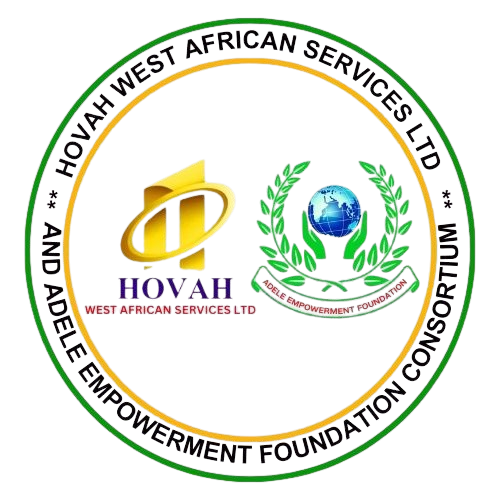NAME OF CONSORTIUM: HOVAH WEST AFRICAN SERVICES LTD & ADELE EMPOWERMENT FOUNDATION
Objective.
To provide high-quality vocational and digital skills training that equips women, people with disabilities, and marginalized youth with employable skills in Nigeria thereby fostering economic empowerment and inclusivity.
- Needs Assessment
1.1 Target Group Analysis:
Identify the specific needs of women, people with disabilities, and marginalized youth in the target community.
Conduct surveys, focus group discussions, and interviews to understand their skill gaps and career aspirations.
1.2 Labour Market Analysis:
Collaborate with local industries, businesses, and employment agencies to identify market demand for vocational and digital skills.
Analyze emerging trends in technology and employment to ensure training remains relevant. - Program Design
2.1 Curriculum Development:
Develop a comprehensive curriculum for each skill area, aligned with the specified industry standards.
Include both technical skills and soft skills such as communication, teamwork, and problem-solving.
Incorporate practical, hands-on projects to enhance learning outcomes.
2.2 Training Delivery Modes:
In-Person Training: Classroom-based sessions at the training centre for hands-on practice.
Blended Learning: Combination of online and in-person sessions to accommodate diverse participant needs.
Assistive Technologies: Specialized tools and resources for people with disabilities to ensure inclusivity.
2.3 Duration:
Program to run over 6 months, with a schedule that includes:
3 months Hands-on practical skills training.
3 months internship placement and mentorship. - Target Beneficiaries
3.1 Demographics:
Women (at least 45% of participants).
People with disabilities (minimum of 20%).
Marginalized youth from underserved communities (35%).
3.2 Selection Criteria:
Demonstrated interest in acquiring vocational and digital skills.
Commitment to completing the program.
2.2 Training Levels:
Offer foundational, intermediate, and advanced levels to cater to diverse skill levels.
Design flexible learning pathways to allow participants to progress at their own pace.
2.3 Inclusion Measures:
Provide accessibility features for people with disabilities, such as assistive technology and adaptive teaching methods.
Ensure equal participation of women through tailored outreach and support initiatives.
- Infrastructure and Resources
3.1 Facility Setup:
Ensure training centres are equipped with modern computers, software, internet access, etc.
Create an inclusive and safe environment, with ramps, accessible restrooms, and other facilities for people with disabilities.
3.2 Trainer Recruitment and Development:
Recruit qualified trainers with expertise in the targeted vocational and digital skills.
Conduct regular Train-the-Trainer (ToT) programs to update trainers on the latest trends and teaching methodologies.
Recruit support staff for administrative and technical assistance.
Recruit mentors to guide participants during internship and job placement.
3.3 Learning Materials:
Develop high-quality training manuals, video tutorials, and online resources for participants.
Provide access to digital tools, software licenses, and online learning platforms. - Training Implementation
4.1 Participant Enrolment:
Launch an awareness campaign using social media, local radio, and community outreach to attract participants.
Use transparent selection criteria to ensure fair access, with priority for the target groups.
4.2 Training Delivery:
Schedule flexible sessions, including evenings and weekends, to accommodate participants’ availability.
Use a blended learning model combining in-person and virtual training to maximize accessibility.
Provide mentorship and coaching to support learners during and after training. - Monitoring and Evaluation
5.1 Key Performance Indicators (KPIs):
Number of participants enrolled, trained, and certified.
Enrolment rates, disaggregated by gender and disability.
Percentage of participants who secure employment, internships, or start businesses.
Completion rates and participant satisfaction scores.
Participant feedback on training quality and relevance.
5.2 Data Collection:
Use pre- and post-training assessments to measure skill acquisition.
Collect feedback through surveys, interviews, and focus groups.
5.3 Continuous Improvement:
Analyze evaluation data to identify areas for improvement.
Update the curriculum and delivery methods based on feedback and market trends. - Sustainability Plan
6.1 Partnerships:
Collaborate with tech companies, NGOs, and government agencies to provide internships, funding, and job placements.
Build a network of alumni to support ongoing mentorship and peer learning.
6.2 Funding:
Diversify funding sources by applying for grants, engaging corporate sponsors, and offering fee-based advanced training modules.
6.3 Certification:
Provide participants with certificates accredited by relevant bodies to enhance their employability.
Establish partnerships with certification providers like CPN, NITDA, Google, Microsoft, or Adobe for industry-recognized credentials. - Timeline
Activity
Responsible Party
Needs Assessment
Consortium Team
Curriculum Development
Training Experts/Certifying body
Facility Setup
Logistics Team
Trainer Recruitment & ToT
HR & Training Experts
Participant Enrolment
Outreach Team
Training Delivery
Trainers
Monitoring and Evaluation
M&E Team
Approval
Centre Manager
Hovah West African Services Ltd and Adele Empowerment Foundation
